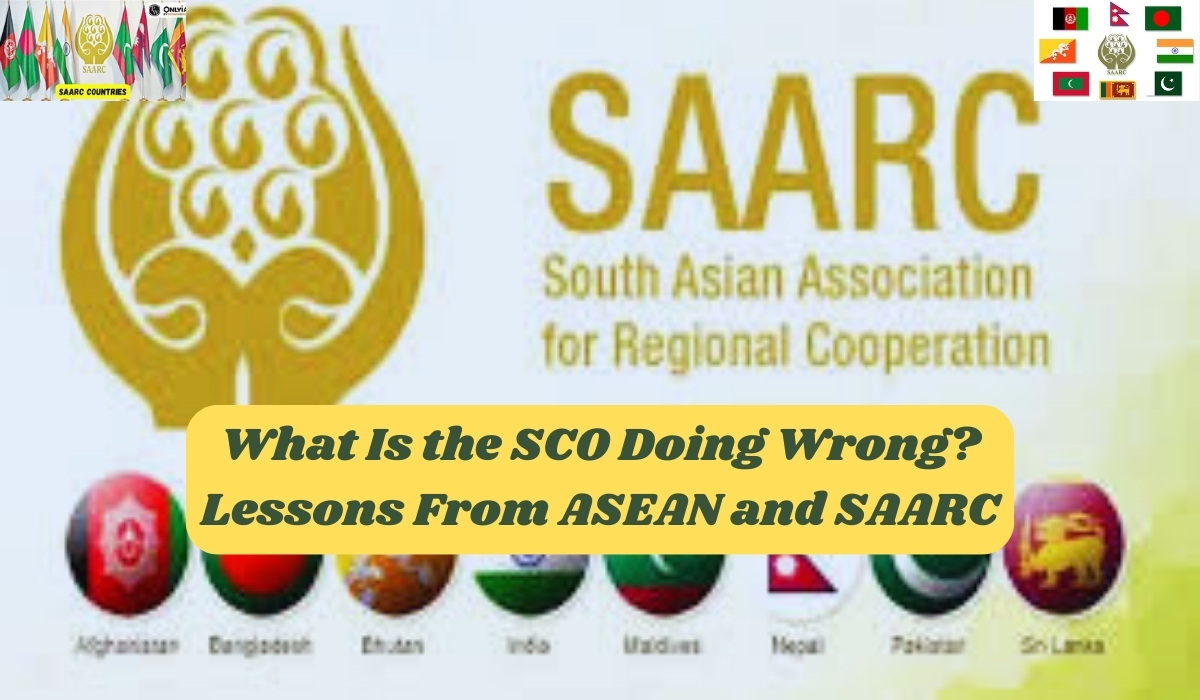“SCO” What Is the SCO Doing Wrong? Lessons From ASEAN and SAARC!

Introduction
The Shanghai Cooperation Organization (SCO) has been a prominent regional entity since its inception in 1996 as the Shanghai Five. Over time, it has expanded to include India, Pakistan, and Iran, aiming to foster cooperation among its member states. However, despite its ambitions, the SCO faces significant challenges that hinder its effectiveness. This article delves into the issues plaguing the SCO, comparing it with other regional organizations like ASEAN and SAARC, and exploring potential lessons it can learn to improve its functionality.
The Current State of the SCO
The SCO recently concluded its annual summit with grand declarations and many initiatives. Despite including Belarus as a new member, the organization struggles to maintain relevance and achieve substantial progress. The SCO’s claims of representing 40% of the global population, 80% of the Eurasian landmass, and a quarter of the worldwide GDP sound impressive, but they mask underlying inefficiencies.
India’s Skepticism and Internal Friction
One of the key issues is the evident discord between India and its regional adversaries, China and Pakistan. Indian Prime Minister Narendra Modi’s absence from the summit highlights the strained relationships within the SCO. This tension undermines the organization’s goal of presenting a united front for a multipolar world order. The expansion of the SCO outside Central Asia has further diluted its effectiveness, exacerbating its internal conflicts.
Institutional Weaknesses and Ineffectiveness
The SCO’s failure to institutionalize cooperation in critical areas such as development, energy, and free trade is a significant drawback. Russia’s apprehension about China’s growing influence in Central Asia has stymied progress. The organization’s formal structures, intended to standardize banking, finance, and business transactions, often serve merely as networking forums.
Security Challenges
The Regional Anti-Terrorist Structure (RATS), the SCO’s core security institution, organizes multilateral military exercises but has limited success in combating terrorism. The inclusion of countries like Iran, Pakistan, and Afghanistan, known for their terrorism issues, complicates the SCO’s counter-terrorism efforts. As a result, the SCO’s security measures often lack tangible results.
Lessons from ASEAN and SAARC
ASEAN’s Consensus-Building Approach
The Association of Southeast Asian Nations (ASEAN) has been relatively successful due to its consensus-building approach. ASEAN’s focus on non-interference and dialogue has enabled democratic and autocratic regimes to work together effectively. The ASEAN Way has fostered cooperation, even in the face of ideological differences.
SAARC’s Political Hurdles
In contrast, the South Asian Association for Regional Cooperation (SAARC) has struggled due to political tensions, particularly between India and Pakistan. SAARC’s inability to hold regular summits and implement agreements like the South Asian Free Trade Agreement highlights the challenges of regional cooperation in politically volatile regions.
Intraregional Trade and Economic Cooperation
ASEAN has significantly boosted intraregional trade, which accounts for 25% of total trade among its members. In South Asia, intraregional trade remains low at 5%, despite the existence of a free trade agreement. Central Asia’s intraregional trade is similarly limited, with major trade flows directed towards Russia, the EU, and China.
Impact of Global Dynamics
Global events such as the COVID-19 pandemic and Western sanctions on Russia have affected trade dynamics in Central Asia. While trade with China has rebounded, Russia’s economic isolation has complicated regional cooperation. Central Asian states have increasingly sought regional cooperation without heavy reliance on Russia or China.
Regional Dynamics in Central Asia
Recent cooperative initiatives in Central Asia have emerged from within the region. Uzbekistan’s opening up, Kazakhstan’s diplomatic efforts, and improved relations between Kyrgyzstan and Tajikistan have driven regional cooperation. However, Russia and China often play spoiler roles, similar to India’s influence in South Asia.
Geographic and Geopolitical Factors
Geographically, Central Asia and South Asia face different challenges. While Central Asian states have major neighbors like Russia and China influencing their trade networks, South Asian countries struggle with India’s dominance. The rivalry between India and Pakistan has severely impacted SAARC’s functionality.
Internal and External Influences
Russia’s distrust of China and its influence over local regimes hinder regional cooperation within the SCO. The fear of Chinese expansionism and Russia’s perception of Central Asia as its sphere of influence has prevented the implementation of significant projects like regional free trade agreements and energy initiatives.
The Role of Regional Leaders
Central Asian leaders often feel overshadowed by powerful figures like Vladimir Putin and Xi Jinping. This dynamic is similar to the influence India wields over its neighbors in SAARC. Unlike ASEAN, where no single power dominates, the SCO and SAARC are heavily influenced by their larger members.
Ideological Differences and Regional Stability
ASEAN has managed to navigate ideological differences among its members, focusing on practical cooperation. In contrast, the legacy of partition and ideological divides in South Asia have rendered SAARC ineffective. The SCO faces similar challenges with the inclusion of India and Pakistan, which have deep-rooted rivalries.
Comparing ASEAN, SAARC, and SCO
ASEAN’s success lies in its ability to foster cooperation despite diverse political systems and historical conflicts. SAARC’s failures stem from political tensions and India’s dominance. The SCO, with its mix of Central Asian, South Asian, and Eurasian members, faces unique challenges but can learn from ASEAN’s consensus-building and SAARC’s pitfalls.
Conclusion
The SCO’s struggle to achieve meaningful cooperation and progress stems from internal discord, geopolitical tensions, and ineffective institutional structures. By learning from ASEAN’s consensus-building approach and avoiding SAARC’s political pitfalls, the SCO can enhance its functionality and relevance. The future of the SCO depends on its ability to foster genuine cooperation among its diverse members, addressing both regional and global challenges.
References
- Al Jazeera. (2023). “Bangladesh imposes curfew, deploys army as job quota protests continue.” Retrieved from Al Jazeera
- The Diplomat. (2023). “What Is the SCO Doing Wrong? Lessons From ASEAN and SAARC.” Retrieved from The Diplomat


